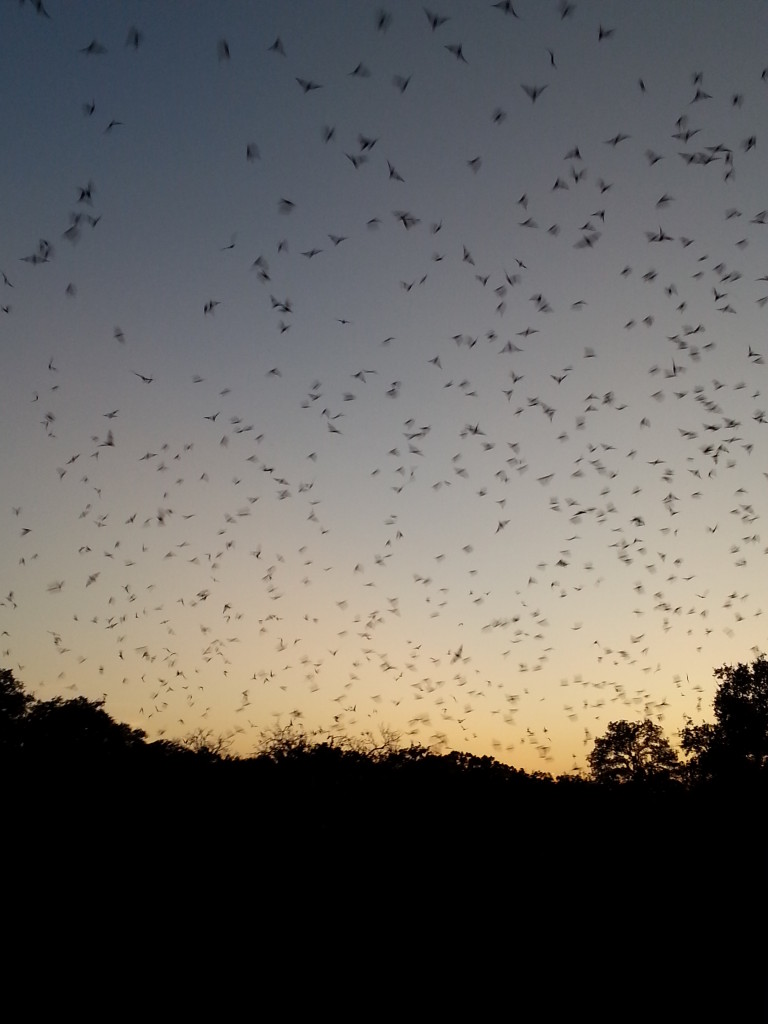Looking for some batty summer fun? As many as 20 million bats spend their summer hanging out in a cave just northeast of town. And you can see these bats in San Antonio if you know where to look.
Each March, some 10-12 million female Mexican Free-tailed Bats migrate from Latin America to roost in Bracken Cave, where they give birth to five to six million (or more) juvenile bats each June. These bats use the surrounding countryside to learn to fly and forage for insects. Every night for three or four hours, these millions of bats spiral counter-clockwise out of the cave each night, on their way to hunt a tasty insect dinner at speeds of up to 60 miles per hour.
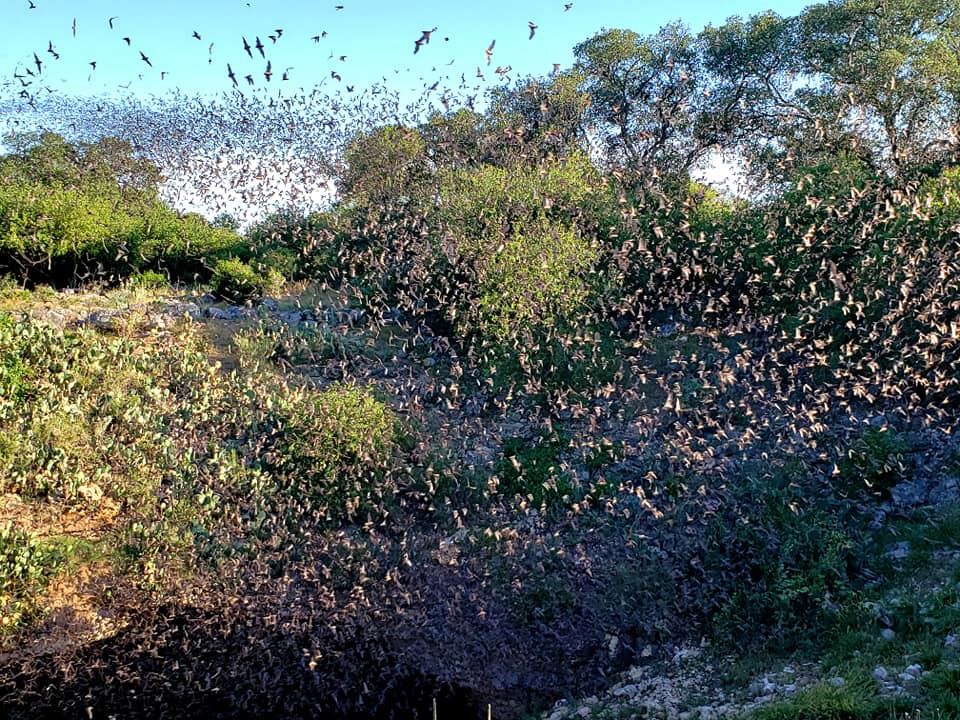
Situated on the Bracken Cave Preserve, almost 700 acres of land owned by Bat Conservation International (BCI). At the height of summer, the Bracken bat colony eats 140 tons of insects each night as these summer residents forage the surrounding countryside and beyond. In fact, they actually travel up to 60 miles away each night, meaning that they complete a 120-mile round-trip to forage, eat, and explore before returning home to the cave at sunrise.
 The preserve is located in southern Comal County, just outside of San Antonio in Bracken, near Natural Bridge Caverns. The unforgettable scene of millions of bats swirling out of the cave and how we non-nocturnals can see this stunning show. Access to the cave is restricted to protect the habitat of the resident bats, but BCI offers guided tours to allow the public to watch the bats emerge from the cave. Additionally, BCI hosts special nights for BCI members, providing them an opportunity to make reservations for a viewing. Founded in 1982 and based in Austin, BCI is devoted to conservation, education and research initiatives involving bats and the ecosystems they serve.
The preserve is located in southern Comal County, just outside of San Antonio in Bracken, near Natural Bridge Caverns. The unforgettable scene of millions of bats swirling out of the cave and how we non-nocturnals can see this stunning show. Access to the cave is restricted to protect the habitat of the resident bats, but BCI offers guided tours to allow the public to watch the bats emerge from the cave. Additionally, BCI hosts special nights for BCI members, providing them an opportunity to make reservations for a viewing. Founded in 1982 and based in Austin, BCI is devoted to conservation, education and research initiatives involving bats and the ecosystems they serve.
Another option is Bracken Bat Flight, a combined cave- and bat-viewing package offered through a partnership between Natural Bridge Caverns and BCI. The package includes a tour of Natural Bridge Caverns, followed by a bat viewing. Check with Natural Bridge Caverns for more details.
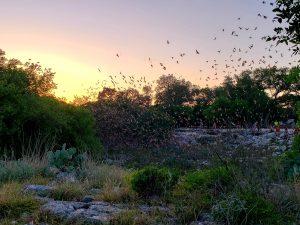 What does a viewing entail? Joining BCI staff and volunteers for a pre-sunset talk about the bats and then front-row seats for a show that must be seen to be believed. As a maternal colony, the Bracken bats feature moms and their babies. (The “daddy bats,” as my son used to call them, and nonreproductive females live separately in bachelor colonies, one of which can be found in downtown San Antonio on the Museum Reach at the Camden Street Bridge. The San Antonio River Authority and BCI host “Bat Loco” events on the Museum Reach that focus on the colony, but this year’s bats are coming out much later than previous years: the spring rains mean more insects/less work foraging, so the Camden Bridge colony may be harder to spot this summer.)
What does a viewing entail? Joining BCI staff and volunteers for a pre-sunset talk about the bats and then front-row seats for a show that must be seen to be believed. As a maternal colony, the Bracken bats feature moms and their babies. (The “daddy bats,” as my son used to call them, and nonreproductive females live separately in bachelor colonies, one of which can be found in downtown San Antonio on the Museum Reach at the Camden Street Bridge. The San Antonio River Authority and BCI host “Bat Loco” events on the Museum Reach that focus on the colony, but this year’s bats are coming out much later than previous years: the spring rains mean more insects/less work foraging, so the Camden Bridge colony may be harder to spot this summer.)
As for the Bracken moms and their babies, neither words nor still photos do them justice. After driving into the preserve—which is gated and only open during hosted events and requires visitors to pre-register to enter—you drive 1.7 miles to the parking area. From there, viewing requires walking a half-mile into the area of the cave. You’re in what looks like an amphitheater, but instead of a stage, there’s a 100-foot-wide hole, and while the sun is still in the sky, you can see bats fluttering about the opening.
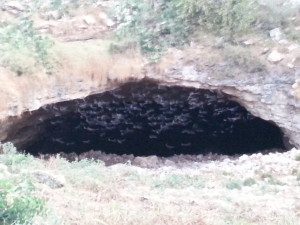
The cave itself is about two football fields long and 80 feet deep, but only researchers venture in and never when the bats are in residence. Honestly, the description of the cave’s insides is not pretty: mites, scorpions, fleas, and bat poop, otherwise known as guano, which is believed to be 19 meters deep or more—the researches would like to do core samples for carbon dating. I appreciate the science behind that, but YUCK. The smell outside of the cave—an occasional whiff of guano on the wind—was more than enough to tell me I don’t need to be any closer.
As the sun begins to set, you stare down into the crescent-shaped opening as you sit on benches and natural rock formations, waiting for the fun to begin. The sun slips lower in the sky, and as it starts to dip below the trees on the horizon, a ribbon begins to spin out of the cave. Few in number at first, then more and more movement as the bats start on their nightly journey. Like you, your fellow viewers are sitting in awed silence as you watch the bats emerge. By the way, bats don’t like noise, so you need to be quiet so as not to interrupt their journey, which isn’t hard because, honestly, words escape you as they continue to spill out of the cave.
The sky above the viewing area fills with bats, and if you cup your hand behind your ears, you can hear their wings as they fly. You can also hear them “talking” to each other: little bat sounds that make you wonder if they’re discussing where they’ll go for the night and what sort of bugs are on their breakfast/lunch/dinner menu.
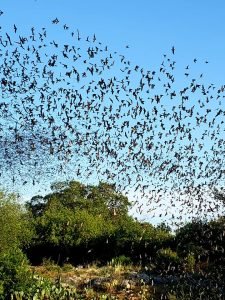 After the bats begin to emerge, BCI volunteers and staff escort you to the back side of the cave—a straight shot from the viewing area, accessible down a gravel path. While you can’t see the mouth of the cave from that angle, the site of the bats filling the sky, with the remains of the setting sun as their backdrop, leaves you with your mouth open as you ponder nature’s beauty and the wonders of these little creatures.
After the bats begin to emerge, BCI volunteers and staff escort you to the back side of the cave—a straight shot from the viewing area, accessible down a gravel path. While you can’t see the mouth of the cave from that angle, the site of the bats filling the sky, with the remains of the setting sun as their backdrop, leaves you with your mouth open as you ponder nature’s beauty and the wonders of these little creatures.
A few misconceptions about our misunderstood nocturnal winged friends: they are not blind or dirty, nor are they looking to nest in your hair. They have excellent vision and, of course, use biological sonar to hunt in total darkness and groom their fur like cats do. And despite what Hollywood would have you believe, they don’t suck blood—at least, not mos of them. Only three of more than 1,300 bat species are vampire bats that feed on blood. All of these reside in Latin America, only one of the three vampire species targets mammals, and that one prefers domestic livestock, so really, you’re safe.
Bats are also not rodents; they’re mammals—and yes, they nurse their young. Some nurse for as long as six months and will carry their babies with them when they fly. Imagine what it’s like to breastfeed while hanging upside down or in flight—c’mon, you know that can’t be easy! Give these little mamas some respect. And while she lives in a colony with millions of other bats, a mama bat can return and find her little one by voice and smell. Once again, bravo, mama bats!
So cool factor aside, why should you appreciate bats? Because they help pollinate a number of plants (including avocados and agave) and their voracious little tummies really like insects. A mother bat can eat up to her body weight in insects every night, and a million bats can eat as much as 10 tons of bugs. That appetite helps save American farmers more than $3.7 billion each year and cuts down on pesticide use.
And while we’re talking bat facts, let’s talk safety. Though the incidence of rabies in healthy bat populations is as low as—or lower than—1%, 10 to 25% of all sick or dead bats found on the ground in Texas test positive for rabies. Anyone handling a bat without wearing gloves may be required to receive preventative rabies shots, so keep in mind and share with your children that a bat found on the ground is not to be touched. You can contact animal control for safe disposal.
A few things to know about the tours—and BCI’s FAQ section is something you should check out if you’re interested in attending a viewing. It will give you tips on what to bring (bug spray is a must, as are closed-toed shoes; binoculars can help you watch as hawks and falcons see if they can snag a bat for dinner; and leave your pets and smokes at home).
First thing to know: this is an adventure that requires planning. You must pre-register, and spots fill quickly, so if this is something you want to do, plan in advance by visiting the BCI webpage to check out public and member nights.
Second: make sure your children are old enough for a viewing. While we once took our four-and-a-half-year-old and have seen young children there , BCI recommends viewing for ages six and up. After attending a viewing, this mom agrees. As cool as this is, it’s hard for children to sit still and stay quiet. For their safety, they can’t roam and play—this is undeveloped land, and while BCI has cleared a great area for viewing, you don’t want your children exploring on their own. The night of our visit, even children ages eight to 10 were losing interest.
Third, consider supporting BCI. With support, BCI can help protect bats and preserve areas like the Bracken Cave, making sure your kids can witness this wonder and perhaps share it with their own children someday.





